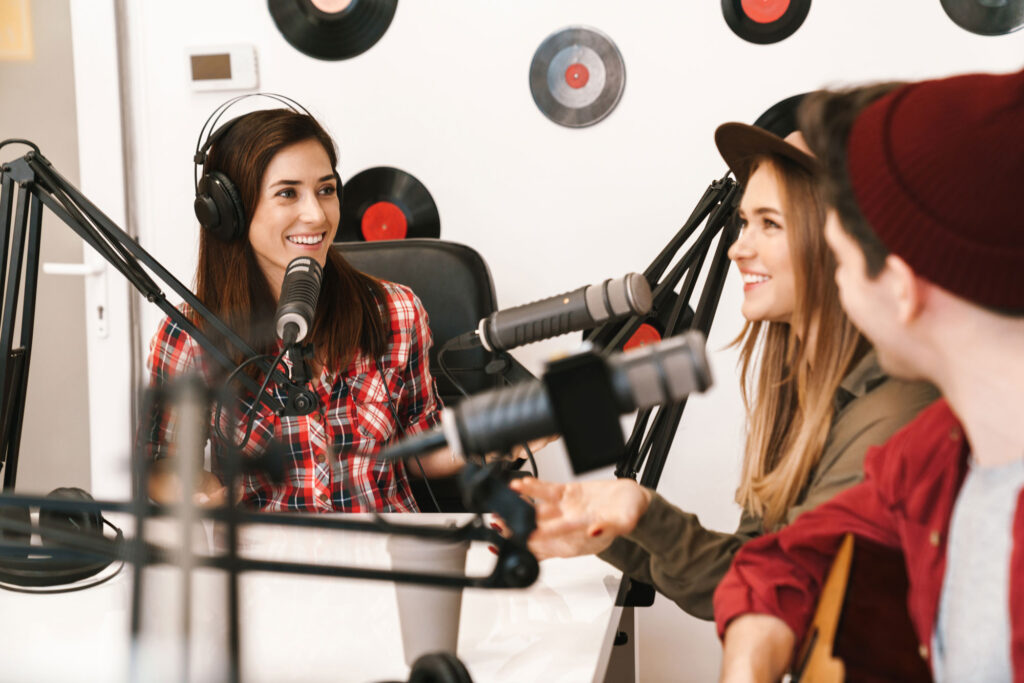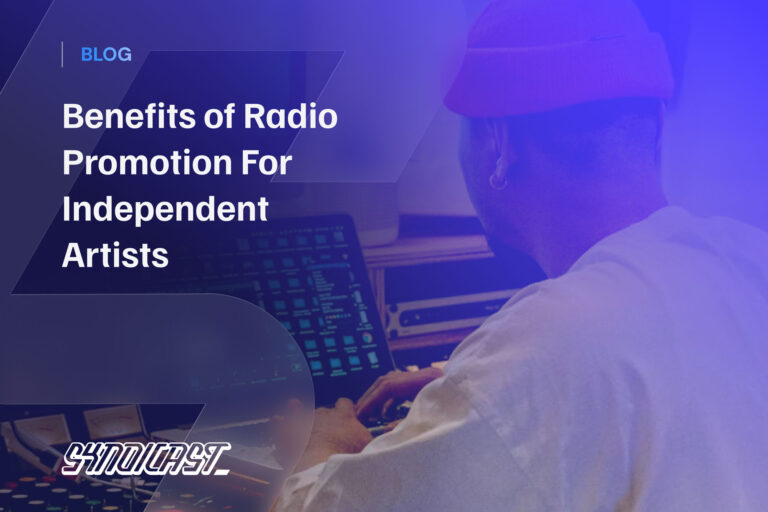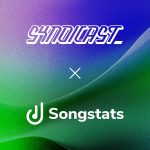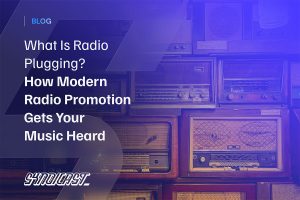In a music industry dominated by streaming and social media campaigns, independent artists might wonder if traditional radio music promotion still holds the key to reaching their target audience.
The answer is a resounding yes. Radio can facilitate speaking directly to your audience and stand out from the background noise of streaming.
Despite the digital shift, radio remains a powerhouse for music discovery, artist credibility, and even revenue generation.
Research consistently shows radio’s enduring reach; for instance, RAJAR figures for Q4 2024 revealed that 87% of the UK adult population (around 50 million people) tune into radio each week, listening for an average of 20.6 hours.
For independent artists, radio advertising and promotion offers a potent trifecta: it builds credibility, fuels discovery beyond self-selected bubbles, and generates crucial royalties.
This article dives deep into these benefits, exploring how you can leverage radio to get your music heard by the masses, build your brand, and boost your income.
In This Article…
- We’ll share our research on the importance of radio promotion in the digital streaming era.
- We’ll analyze high impact benefits independent artists can achieve with radio promo services.
- Learn how Syndicast’s radio services are designed for simplicity, reach, and effectiveness.
- Discover a bunch of other useful tips for maximizing your growth as an indie artist.
Radio’s Reach & Discovery Power – Even in “The Streaming Era”
Radio’s strength lies in its unique ability to combine mass reach with passive discovery. Unlike streaming services, where listeners often actively curate playlists or are served algorithmically similar tracks, radio offers a “lean-back” experience. Listeners tune into trusted stations and DJs, open to hearing something new alongside familiar favourites. This creates a vast opportunity for independent artists to reach audiences who might never encounter them through targeted ads or algorithm-driven suggestions.
The demographic breadth of radio is also a significant advantage. While younger audiences heavily engage with streaming and social media for discovery (MIDiA Research notes TikTok and YouTube lead for 16-24s), radio remains a dominant discovery source across broader age groups.
Radio Ink data from late 2024 showed AM/FM radio tied with streaming services as a top source for music discovery in the US (43% of respondents), with significant listenership among Gen Z (38%) and Millennials (54%). In the UK, radio’s pervasive presence in homes, cars, and workplaces ensures your music can permeate daily life across diverse listener segments.
This contrasts sharply with the “skip culture” prevalent on many streaming platforms. While user control is a benefit of streaming, it can also mean new or unfamiliar tracks are quickly dismissed. Radio’s format, with curated shows and DJ endorsements, encourages listeners to give songs a chance, fostering genuine discovery and connection.

The 7 Top Benefits of Radio Promotion for Independent Artists
Radio airplay isn’t just about a fleeting moment on the airwaves; it can trigger a cascade of benefits for mainstream and independent artists. The following benefits outline a diverse range of reasons why independent artists need to get their music played on stations.
1. Audience Scale
As highlighted, radio reaches millions weekly. Nielsen data for Q4 2024 showed that traditional radio accounted for a staggering 67% of daily ad-supported audio time in the US. This sheer volume means your music has the potential to build an emotional connection with a large audience, far beyond your existing social media followers or streaming bubble. It’s a great way to get multiple exposures while maximizing cost effectiveness to gain customer loyalty.
2. Brand Credibility – The “As Heard On…” Factor
There’s an undeniable prestige that comes with radio play. Hearing your track introduced by a respected DJ or featured on a well-known station gives you some clear street cred. This “as heard on…” credibility can be a powerful tool.
It signals to listeners, industry professionals, and potential collaborators that your music has been editorially approved and is worth paying attention to. Radio interviews and features also allow artists to share their story, building a deeper narrative and connection with audiences. Whether you’re getting your first radio spot on college radio/talk radio, or other channels with a bigger reuptation – all of this helps to get you a broad reach.
Don’t avoid the college stations either, as these give smaller artists the perfect opportunity to get their first foothold.
3. Chart & Playlist Leverage
Radio airplay directly contributes to official chart positions in many territories, including the UK, US, and around the world. Significant spins on reporting stations can propel your track into these charts, further boosting visibility. The nature of radio means you can convey complex information about the artists, which can build more brand loyalty, compared to the more faceless nature of streaming.
While the link to major streaming platform editorial playlists isn’t always direct, the buzz, increased streams, and listener engagement generated by radio play can significantly improve your chances of being noticed by human curators on services like Spotify and Apple Music. Apple Music, for example, tracks radio spins from over 40,000 stations as part of its artist analytics.
4. Royalty Income Streams Explained
This is a crucial benefit often misunderstood. When your music is played on the radio in the UK, you are entitled to performance royalties. These are collected by two main Performing Rights Organisations (PROs):
- PRS for Music: Collects and distributes royalties to songwriters, composers, and music publishers for the public performance and broadcast of their musical works.
- PPL UK: Collects and distributes royalties to performers (featured artists, session musicians) and record labels (recording rightsholders) for the use of their recorded music.
For radio broadcasts, PPL typically distributes 50% of the collected revenue to the recording rightsholder and 50% to eligible performers. The amount earned per play varies significantly based on the station’s audience size, the time of day, and whether it’s a “census” station (like all BBC stations and major commercial stations, which report every track played) or a “sampled” station (smaller stations that report playlists for a sample period).
A single play on a major station like BBC Radio 2 can generate substantial royalties, potentially more than hundreds of thousands of streams. Consistent A-list rotation on a national station could translate to over £1,000 per week for a songwriter (PRS, based on 2020 figures for a 4-minute song).
5. Territory Insights for Touring
Radio airplay, especially when tracked globally, provides invaluable data on where your music is resonating. Services that monitor radio spins (like WARM, integrated into Syndicast campaigns) can show you which cities, regions, or countries are playing your tracks.
This geographic data is gold for planning effective tours, targeting promotional spend for radio ads and digital ads, and demonstrating to promoters in specific areas that you have an existing listener base, and gives you valuable insights on specific demographics.
6. Social-Media Content Opportunities
Radio play is a milestone worth celebrating and sharing! Sharing the radioplay success of your new release with a social media message is a great way to conenct with your fans.
Announce your upcoming radio feature, thank the station and DJ live on air or afterwards, share clips (if permissible), and encourage fans to listen and tag you. Let fans know where they can tune in and encourage them to tag you if they hear it live.
Screenshots of airplay reports, photos from station visits, or a simple “thank you” graphic can all make engaging content.
7. Long-Tail Spike on Digital Service Providers (DSPs)
While radio’s most immediate impact might be on initial discovery and sales/streaming spikes (a 2013 Nielsen study showed a strong correlation between airplay and digital sales/on-demand streaming), it can also contribute to the long-tail life of a song.
By introducing your music to a broad audience, radio drives listeners to seek out your tracks on Spotify, Apple Music, and other DSPs. This initial surge can boost your algorithmic profile and help your music find its way to more listeners over time, lengthening the song’s lifecycle.
Unlock Radio Promotion Benefits with Syndicast
Navigating radio promotion can be daunting for independent artists. This is where Syndicast steps in.
We offer a powerful, transparent, and cost-effective radio promotion platform designed to get your music into the hands (and ears) of over 2,400 verified radio stations and shows in more than 120 countries.
Here’s the Syndicast value for independent artists
- Global Reach: Connect with music directors and radio host DJs worldwide.
- Targeted Promotion: Our system helps match your music to the right stations.
- Professional Presentation: We can facilitate “Artist Promo” edits, where you introduce your track, adding a personal touch with sound effects and identity.
- Real-Time Airplay Monitoring: Through our integration with WARM (World Airplay Radio Monitor), you get detailed reports for one year, seeing exactly where and when your music is played.
- Enhanced Credibility: Editorial selection by radio stations boosts your artistic profile.
- Cost-Effective: Our campaign packages (starting from £390 for a 4-week “Standard” campaign to £850 for a 12-week “Pro” campaign) are significantly more affordable than traditional radio pluggers who often focus on a single territory and can cost thousands.
- Direct Insights: Use your airplay data to understand your audience and inform your strategy.
Ready to get your music heard on radio stations across the globe? Explore Syndicast’s radio promotion campaigns today!
FAQs About the Benefits of Radio Promotion Services
How do independent artists get on the radio? How to get radio airplay?
Independent artists can achieve radio play by directly submitting their music to local, community, student, and online stations or by utilizing platforms like BBC Introducing in the UK for wider BBC network consideration.
For broader, more targeted campaigns, artists can hire professional radio pluggers who have established industry contacts or use global radio promotion services like Syndicast, which distribute music to extensive networks of stations at a more accessible price point.
How do independent artists promote themselves?
Independent artists promote themselves through a multifaceted approach that includes building a strong digital presence with engaging social media and a professional website/EPK, optimizing their profiles on streaming platforms and pitching for playlists, and cultivating a fan base through live performances.
This is often complemented by PR efforts to secure media coverage in blogs and magazines, active networking within the industry, and strategically pursuing radio promotion to reach new audiences and enhance credibility.
Is radio promotion worth it in the modern music industry?
Yes, for many independent artists, radio promotion is a worthwhile investment due to its potential for mass audience reach, significant credibility boost, generation of royalty income (via PPL/PRS in the UK), impact on charts, and discovery by new fans and industry professionals.
While DIY efforts are time-consuming and professional pluggers can be costly (ranging from £500 to over £3000 in the UK), platforms like Syndicast offer more affordable global campaign options (from £390-£850), making radio a valuable tool for building momentum when aligned with an artist’s goals and budget.










